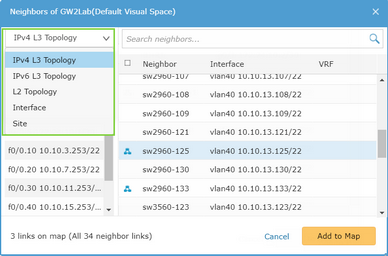Extending Neighbors
You can draw different types of topology links and neighbor devices on one map page concurrently by extending neighbors, including layer 2 topology, IPv4 layer 3 topology, IPv6 layer 3 topology, and Layer 3 VPN Tunnel, as long as the topologies have been built in the system.
1.On your map, click the  icon attached to the target device, site or MPLS cloud.
icon attached to the target device, site or MPLS cloud.
2.Extend and draw neighbors on the map.
1)Select a neighbor type (such as IPv4 L3 neighbor device, L2 neighbor device, or neighbor site) from the drop-down menu to filter neighbors. See Neighbor Types for more details.

Note: To extend neighbors in L2/IPv6 L3 topology, or L3 VPN tunnel, make sure that the topology type has been built via a Benchmark task. See Benchmark Task Settings for more details.
2)Select an interface in the left pane. The connected neighbor devices or sites are listed on the right side.
3)Select one or multiple neighbor devices or sites, and then click Add to Map. You can also double-click All Neighbors to add all the listed neighbor devices to the map.
Tip: To extend neighbors for a DMVPN cloud, right-click the DMVPN cloud and select Extend Neighbor.
3.Repeat the above steps to extend neighbors for more devices, sites or MPLS clouds.
Tip: There are three types of relationships between a site and a device, which are shown in different ways on a map. See Connectivity between a Device and a Site on a Map for more details.
Neighbor Types
The table below lists all neighbor options and the corresponding interfaces that can be selected when you extend neighbors.
Neighbor Option |
Interface |
|---|---|
IPv4 L3 Topology |
Includes all Layer 3 interfaces of the target device or the Layer 3 PE interfaces of the target MPLS cloud, which are configured with IPV4. |
IPv6 L3 Topology |
Includes all Layer 3 interfaces of the target device, which are configured with IPv6. |
L2 Topology |
Includes all Layer 2 interfaces of the target device. |
L3 VPN Tunnel |
Includes outside interface of the target device. |
Interface |
Includes all interfaces (including both Layer 3 and Layer 2 interfaces) of the target device or MPLS cloud. |
Site |
Includes all device interfaces connected with the site or all PE interfaces of an MPLS cloud connected with the site. |
Device |
Includes all border interfaces on the border devices of the target site. |
Connectivity between a Device and a Site
When you extend neighbor devices for a site, the connectivity on a map might be one of the following:
Connectivity on Map |
Description |
|---|---|
The device is an inner device of this site, indicating that it is not connected to any devices from other sites. |
|
The device does not belong to the site, and connected to a device (BJ-R1) within the site. |
|
The device is a border device of this site, indicating that it is connected to devices in other sites. |
See also:
▪Site



